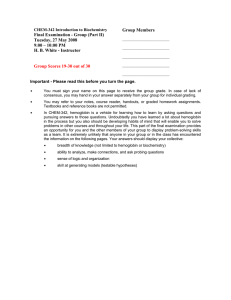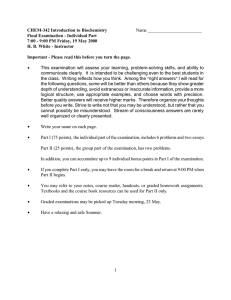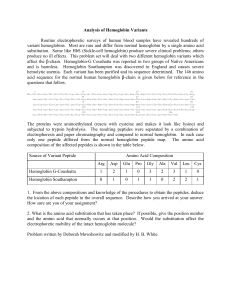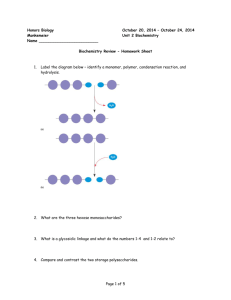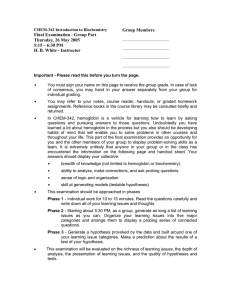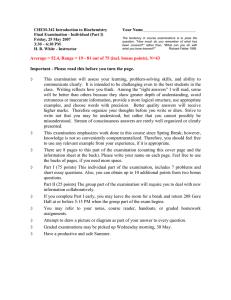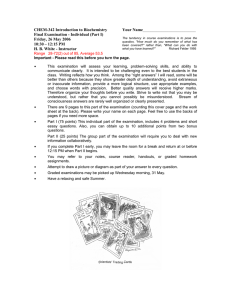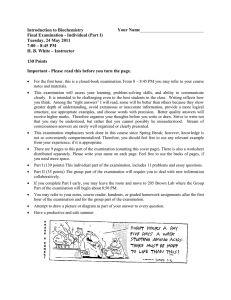CHEM-342 Introduction to Biochemistry Final Examination - Individual Part
advertisement
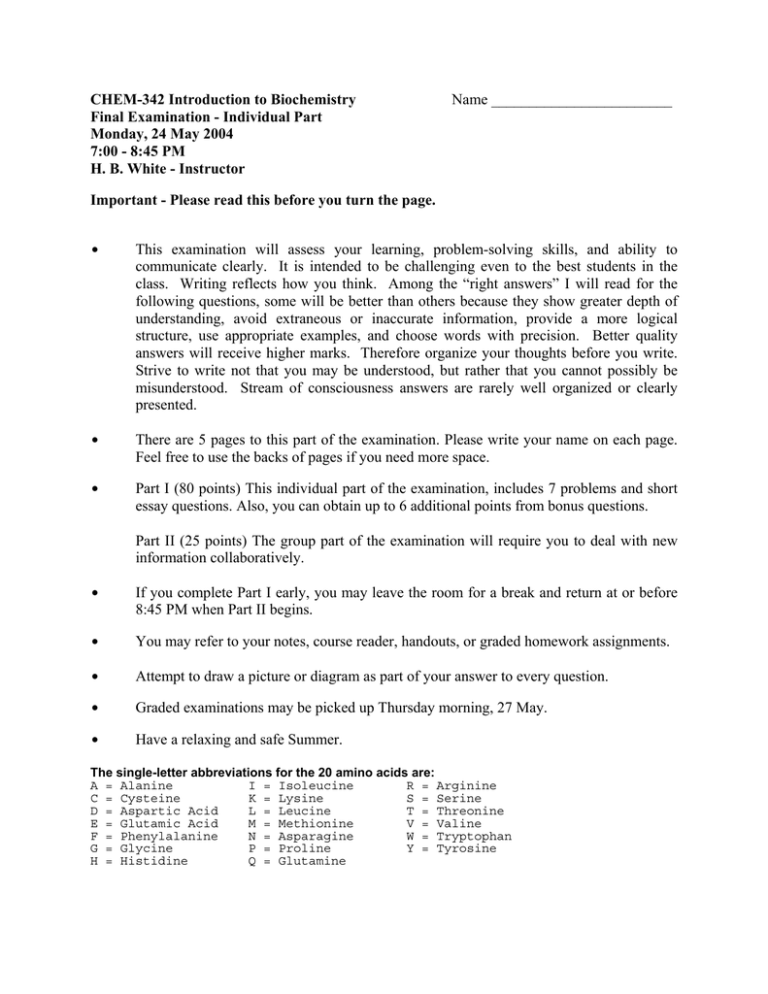
CHEM-342 Introduction to Biochemistry Final Examination - Individual Part Monday, 24 May 2004 7:00 - 8:45 PM H. B. White - Instructor Name ________________________ Important - Please read this before you turn the page. $ This examination will assess your learning, problem-solving skills, and ability to communicate clearly. It is intended to be challenging even to the best students in the class. Writing reflects how you think. Among the “right answers” I will read for the following questions, some will be better than others because they show greater depth of understanding, avoid extraneous or inaccurate information, provide a more logical structure, use appropriate examples, and choose words with precision. Better quality answers will receive higher marks. Therefore organize your thoughts before you write. Strive to write not that you may be understood, but rather that you cannot possibly be misunderstood. Stream of consciousness answers are rarely well organized or clearly presented. $ There are 5 pages to this part of the examination. Please write your name on each page. Feel free to use the backs of pages if you need more space. $ Part I (80 points) This individual part of the examination, includes 7 problems and short essay questions. Also, you can obtain up to 6 additional points from bonus questions. Part II (25 points) The group part of the examination will require you to deal with new information collaboratively. $ If you complete Part I early, you may leave the room for a break and return at or before 8:45 PM when Part II begins. $ You may refer to your notes, course reader, handouts, or graded homework assignments. $ Attempt to draw a picture or diagram as part of your answer to every question. $ Graded examinations may be picked up Thursday morning, 27 May. $ Have a relaxing and safe Summer. The single-letter abbreviations for the 20 amino acids are: A = Alanine I = Isoleucine R = Arginine C = Cysteine K = Lysine S = Serine D = Aspartic Acid L = Leucine T = Threonine E = Glutamic Acid M = Methionine V = Valine F = Phenylalanine N = Asparagine W = Tryptophan G = Glycine P = Proline Y = Tyrosine H = Histidine Q = Glutamine CHEM-342 Introduction to Biochemistry Final Examination-Individual Part, 24 May 2004 Name________________________________________ Page 2 1. (5 points) You were asked to attend two biochemistry-related research seminars this semester. Describe one. (Speaker, topic, anything you learned) 2. (10 points) Ruud [Nature 173, 848-850 (1954)] describes fish from Antarctic waters that lack red blood cells and hemoglobin. These fish from the family Channichthyidae are unique among fish in having transparent blood. Knowing what you know about hemoglobin, list five substantive learning issues you would want to ask relating to these fish. 3. (5 points) Dr. Lois Dow was studying the production of mRNA in red blood cells from people with thalassemia. What is thalassemia? Is there reason to think mRNA levels might be different in some people with thalassemia? CHEM-342 Introduction to Biochemistry Final Examination-Individual Part, 24 May 2004 4. Name________________________________________ Page 3 Screening of hemoglobins in blood samples revealed the interesting case of a husband and wife who were each heterozygous for a different hemoglobin variant. Based on the electrophoretic pattern, researchers initially thought the husband was heterozygous for HbC (α2β26Glu→Lys).and his wife heterozygous for HbS (α2β26Glu→Val). However, when they studied the electrophoretic patterns for hemoglobin in the children of the family, it was apparent that the father’s mutation affected the alpha chain and not the beta chain as would be the case for HbC. a. (10 points) In the space indicated, depict the pattern that would be observed in at least one child that would not be seen if the father were actually heterozygous for HbC. − Origin Mother (HbA/S) ׀ Father (HbA/“C”) ׀ Child ׀ + Explain. b. (5 points) The new variant was purified and digested with trypsin. The resulting two-dimensional peptide map (“fingerprint”) showed the loss of one and the gain of two new peptides compared to the alpha chain of HbA. Why would this be expected based on the electrophoretic mobility (of Hb“C”)? c. (10 points) One of the new spots turned out to be a tripeptide with the composition: glycine, lysine, and glutamic acid. Amino terminal analysis of that peptide revealed glutamic acid. Draw the complete covalent structure of the tripeptide in the space below. Bonus: (2 points) What would be the net charge on this peptide at pH 7.0? CHEM-342 Introduction to Biochemistry Final Examination-Individual Part, 24 May 2004 5. Name________________________________________ Page 4 The abundance, relatively small size, and ease of purification made hemoglobin an early target for studies in comparative biochemistry. Not only did protein chemists determine the amino acid sequences of many human hemoglobin variants, they sequenced the α and β globin chains from many different animals. An early discovery was that the α and β globin chains had related sequences and resulted from an ancient gene duplication. The diagram below displays the large number of amino acid identities in an aligned portion of the human globin chains. 12 23 24 25 26 27 28 29 30 31 Human alpha A A W G K V G A H A G E A L W G K V N V D E Human beta Y V G G A G E E A A L L E G R R 23 24 25 26 27 28 29 30 13 13 14 14 15 15 16 16 17 17 18 18 19 19 20 21 20 22 21 22 In 1962, Zuckerkandl and Pauling formulated the molecular clock hypothesis. They had shown that the number of amino acid differences between corresponding proteins, e.g. β globins, from different animals increased the more distantly the animals were related. This was perfectly consistent with the principles of evolution. They proposed that one could estimate the time since a common ancestor by determining the number of difference between two proteins and a knowledge of how fast the particular protein was evolving. By comparing many proteins the error in the estimate of when a common ancestor lived could be improved. For β-globin, there is on average one amino acid replacement per 6 million years. This is consistent with the identity or near identity of β-globin from humans, chimpanzees, and gorillas. a. (10 points) Below are listed the $-globin amino acid sequences for human, horse, and fruit bat. Based on the molecular clock hypothesis, which pair of animals is most closely related? State your reasons. b. (5 points) Estimate how many years ago these two had a common ancestor. c. (5 points) Mark with a vertical line each place trypsin would hydrolyze a peptide bond in each sequence. Human Horse Fruit Bat 10 20 30 40 50 60 70 | | | | | | | VHLTPEEKSA VTALWGKVNV DEVGGEALGR LLVVYPWTQR FFESFGDLST PDAVMGNPKV KAHGKKVLGA VQLSGEEKAA VLALWDKVNE EEVGGEALGR LLVVYPWTQR FFDSFGDLSN PGAVMGNPKV KAHGKKVLHS VHLSGEEKSA VTSLWGKVKV DEVGGEALGR LLVVYPWTQR FFDSFGDLSS ASAVMGNAKV KAHGKKVLDS 80 90 100 110 120 130 140 | | | | | | | FSDGLAHLDN LKGTFATLSE LHCDKLHVDP ENFRLLGNVL VCVLAHHFGK EFTPPVQAAY QKVVAGVANA LAHKYH FGEGVHHLDN LKGTFAALSE LHCDKLHVDP ENFRLLGNVL VVVLARHFGK DFTPELQASY QKVVAGVANA LAHKYH FSEGLQHLDS LKGTFAKLSE LHCDKLHVDP ENFRLLGNVL VVVLARHFGK EFTPQLQAAY QKVVAGVATA LAHKYH Bonus: (2 points) How many sulfur atoms are in each beta globin listed. CHEM-342 Introduction to Biochemistry Final Examination-Individual Part, 24 May 2004 Name________________________________________ Page 5 6. (5 points) In a population where 4.0% of the newborn children develop sickle cell disease, what is the expected percentage of newborn children in that population who do not have s sickle cell gene? i.e. only produce HbA and not HbS? 7. (10 Points) Essay. Thomas Kuhn, a prominent recent philosopher of science said, Discovery commences with the awareness of anomaly, that is, with the recognition that nature has somehow violated the pre-induced expectation that governs normal science. Based on your readings this semester, do you think quotation captures what happened in discoveries about hemoglobin? Bonus: (2 points) Who was an important scientist involved in establishing St. Jude’s Children’s hospital in Memphis?

